Like Much Of The Andes
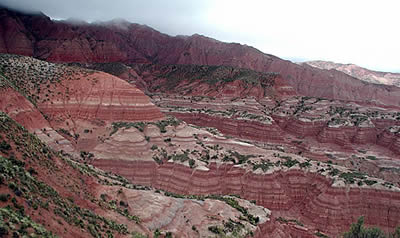
Photo via Science
When asked if mountains grow slowly and steadily versus in rapid spurts, most people intuitively gravitate to the "slow and steady" model. Mountains, we are taught, have an incomprehensibly long time to build up their scads of boulders, jagged peaks and high-altitude plateaus.
In fact, near known mount building processes practise require big amounts of time to complete their skyward climb. But for every rule there is an exception. Consider the Himalaya and Andes mountains — despite their relative geologic youth, these mount belts rank amid the world'south tallest peaks. And therein lies the mountainous paradox: How exercise geologically young mountains grow extremely tall in extremely short time periods?
A recent study tracking the uplift of a central portion of the massive Andes Mountains in Southward America shows that mountain building — what geologists term "orogeny" — may actually occur in much faster fits and spurts than previously realized due to the rapid loss of large amounts of textile from the mount's root.
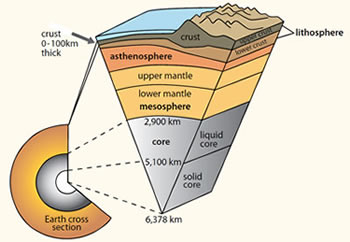
Conventional geology tells us that as the world's tectonic plates collide and dive beneath 1 another, and these actions cause the world'due south skin to crumple and fold. Below the surface, mountains have deep roots where dense material accumulates over time. It was previously thought that a gradual erosion of this root resulted in the gradual rise of the crust: Equally weight was worn off the bottom, the top rose.
This theory would predict that the Andes Mountains rose gradually and in sync with the scrunching of the Nazca plate beneath the South American plate, a process that caused dumbo fabric to accumulate upwardly to 70 kilometers deep over thousands of years below South America'due south western coast. But Florida Museum of Natural History paleontologist Bruce MacFadden, a co-author of last year's June half-dozen study in Scientific discipline, said that this did not happen.
"Instead of the Altiplano rise piddling by trivial each year, we plant ii phases of spasmodic or punctuated uplift interspersed by millions of years of stability," MacFadden said.
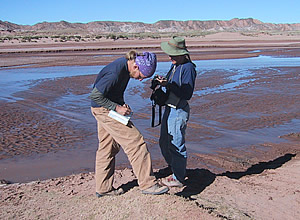
Florida Museum photo by Bruce MacFadden
The authors assert that every bit the crustal layer (which floats above the mantle and is known every bit the lithosphere) was squeezed under deforming pressures, large parts of the accreted fabric plummeted downward into the more plastic upper mantle layer (known every bit the athenosphere). This loosening of the root load caused the surface crust layer to rise, buoyed upward like a released cork.
"Our findings will force geologists to acknowledge that removal of lower lithosphere material could be an important procedure that causes rapid surface uplift in different mountain belts worldwide and over geologic time," said lead writer Carmala Garzione, a geologist at the University of Rochester.
Geochemical clues
The researchers found that Andes uplift began between 30 million and 20 1000000 years ago. It so leveled off into relative stability until "a pulse of rapid uplift" occurred between 10 1000000 and 6 million years ago, when the landscape rose betwixt 1.5 and iii.five kilometers. To reconstruct the Altiplano's sequential rise, the researchers examined several lines of proxy show including ii different types of stable isotopes, fossil plants and aboriginal magnetic-bearing deposits.
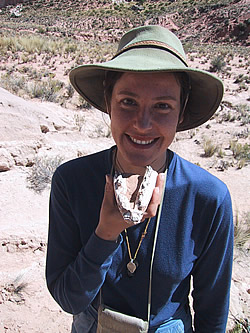
Florida Museum photo past Bruce MacFadden
The researchers coaxed geochemical clues in the class of oxygen isotopes from ancient soil nodules made of calcium carbonate. The nodules were sampled from layered soil deposits between five 1000000 and 28 million years old. Oxygen isotopes serve as reliable proxy indicators for the actual temperatures in which they formed. The researchers used them to reconstruct ancient temperature records and then linked these records to known temperature clines associated with vertical elevation gain. They likewise analyzed magma and sediment as boosted proxies.
"Carmie's ability to put this study together shows her brilliance," MacFadden said. "She's synthesized inquiry in theoretical geophysics, geochemistry, and paleontology and made a strong case for the timing and consequences of the Altiplano'south rise."
A professor of earth and environmental sciences at Lehigh Academy who also researches ancient elevations said that while weaknesses were inherent when single proxy methods were used, the multiple methods used in this study fabricated the results robust.
"Remarkably, the rapid recent uplift scenario presented here is similar to what I constitute for the Colorado Plateau," Dork Sahagian said. "The greatest novelty in their written report is the number of proxies they brought to bear upon the problem. This is the right style to get virtually it."
Reconstructing ancient topographies, climates
MacFadden, who has spent about iii decades collecting and studying fossil mammals from Republic of bolivia, contributed by leading the research team to several key fossil sites in the Altiplano where he had previously established geological age sequences. While Garzione'due south interest was grounded in the geology, MacFadden's involvement in the project lay in understanding how the Andes' birth affected South America's ancient climate and animals.
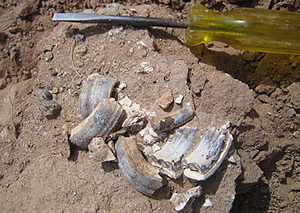
Florida Museum photograph by Bruce MacFadden
"The big-picture question is: When did the Andes abound loftier plenty to become drivers of the Southward American climatic authorities?," MacFadden said. "Because this event obviously had cascading furnishings upon plant and animal life across the continent."
Based on their findings, MacFadden said this probable happened around 10 million years ago.
Today, the massive Andes Mount belt snakes four,400 miles along the continent's western edge and is the longest unbroken terrestrial chain on the planet, with peaks soaring to 22,841 feet. The world's driest desert, the Atacama, stretches between the Andes' central western foothills and the Pacific Ocean. 6 hundred miles to the east, beyond the Bolivian burl at the Andes' widest point, the globe's largest drove of wetlands form the Pantanal.
"If we could rewind a video of the Andes' formation," MacFadden said, "nosotros'd see how they grew into an immense force, affecting the distribution and abundance of moisture across large portions of South America."
Boosted study co-authors include: Gregory Hoke, University of Rochester; Julie Libarkin and Saunia Withers, Michigan State University; John Eiler, California Institute of Technology; Prosenjit Ghosh, Eye for Atmospheric and Oceanic Scientific discipline; and Andreas Mulch, Universität Hanover in Germany.
What'south in a name? Sometimes a genus
The Journal of Vertebrate Paleontology published a clarification of the genus Brucemacfaddenia in May 2008. A longtime South American colleague of MacFadden'due south, paleontologist Federico Anaya of the Universidad Autónoma Tomás Frías in Bolivia, as well had a genus named for him in the journal commodity, Federicoanaya.
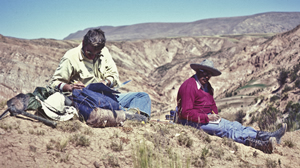
Florida Museum photo by Bruce MacFadden
Since the early 1980's, MacFadden and Anaya have collected and studied fossils beyond Bolivia and in the Salla Beds, which preserved many mammal species. These deposits were too sampled for MacFadden's most recent report on mount building (run across main story).
An contained research team headed by Ralph Hitz of Tacoma Customs College named the two new genera of notoungulates — an extinct biological lodge of pocket-sized- to medium-hoofed herbivorous mammals endemic to South America — later on the two paleontologists in honor of their extensive contributions to describing and studying the evolutionary history of South America's aboriginal mammals.
Hitz, who first went on a field expedition with MacFadden as a graduate student in 1994, said that it was due to MacFadden'south efforts that the "full relevance of this important fauna" came to exist recognized.
"I was also impressed that he was engaged in the place of research as much equally the objects of enquiry," Hitz said, "by which I hateful he fully involved local institutions and paleontologists in the program, and besides spent a considerable amount of time in La Paz teaching at the university."
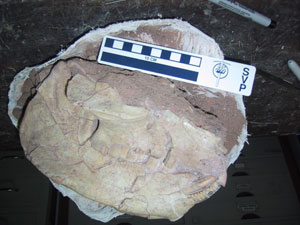
Florida Museum photograph by Bruce MacFadden
Hitz said he chose to besides award Anaya because of his perseverance and dedication to studying paleontology in Bolivia.
While new species are often named after relevant scientists as an honorary gesture, it isn't typically a common practice at the genus level. Co-ordinate to Florida Museum vertebrate paleontologist Richard Hulbert, an Argentinean paleontologist started the tradition in 1901 of naming new South American ungulate genera after famous paleontologists and mammalogists — stringing together both their first name and surname. This practise has since been used to depict more than xxx new S American genera, according to Hitz.
MacFadden said he was a little embarrassed when he learned of Brucemacfaddenia boliviensis, the genus and species described in the journal, but other colleagues in his field say the gesture is fitting due to the breadth of his contributions.
"Dr. MacFadden devoted a considerable portion of his career working in Bolivia, leading very successful fossil-collecting expeditions there, studying and dating the stone layers, producing the fossils, and assisting and training Bolivian scientists," Hulbert said. "The most productive and significant region he worked in was the Salla Beds, which produced the fossils of Brucemacfaddenia."
Learn more aboutVertebrate Paleontology at the Florida Museum.
Like Much Of The Andes,
Source: https://www.floridamuseum.ufl.edu/science/the-andes-mountainous-paradox-so-tall-so-young/
Posted by: kelleyandon1984.blogspot.com


0 Response to "Like Much Of The Andes"
Post a Comment